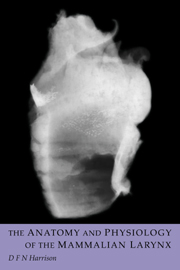4 - Detailed morphology
Published online by Cambridge University Press: 05 October 2010
Summary
Development of the larynx
For many years embryologists have avoided a mechanistic analysis of craniofacio-cervical morphogenesis, largely because of the three-dimensional complexity of these regions. Despite its anatomical intricacy, development is more profitably explained in molecular or genetic terms and the genome is often analogized as a genetic blueprint. Genes involved in embryogenesis, however, more accurately serve as a set of assembly rules whose implementation and interaction govern the transition from one-dimensional information of the genotype into the three-dimensional complexity of the phenotype (Thorogood & Ferreti, 1992). The analysis of the development of the embryo is often achieved by the use of model systems or is extrapolated from the study of nonhuman vertebrates. Since evolution is a conservative process retaining and refining efficient morphogenetic processes, causal mechanisms are conserved over many years simply because they generate a successful phenotype. This appears to be true for the mammalian larynx where much of our knowledge has come from a detailed study of the human embryo. Although the development of the human larynx was described in 1820 by Fleischmann (cited by Soulie & Bardier, 1907) it was not until the pioneer work of His in 1885 on the development of the gastrointestinal tract and pharyngeal arches that serious attention was paid to the larynx.
- Type
- Chapter
- Information
- The Anatomy and Physiology of the Mammalian Larynx , pp. 48 - 184Publisher: Cambridge University PressPrint publication year: 1995
- 1
- Cited by

